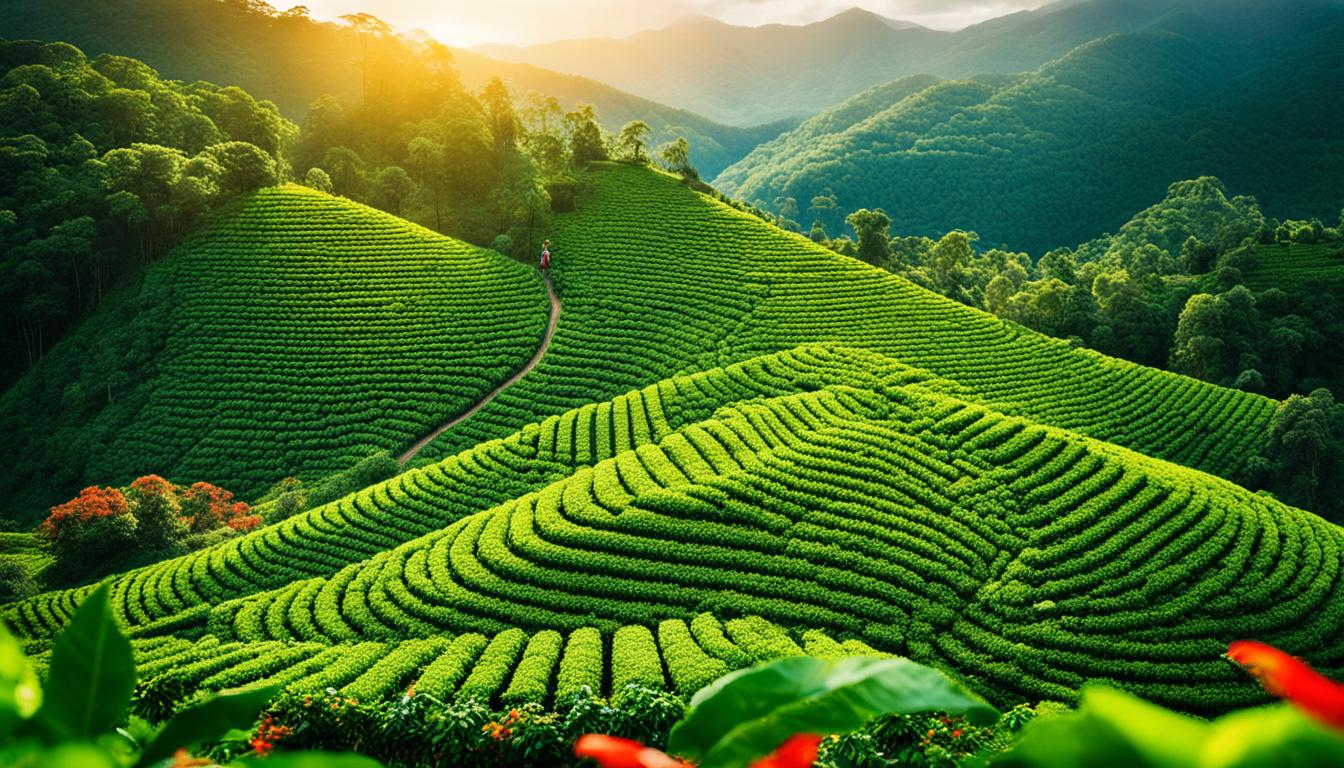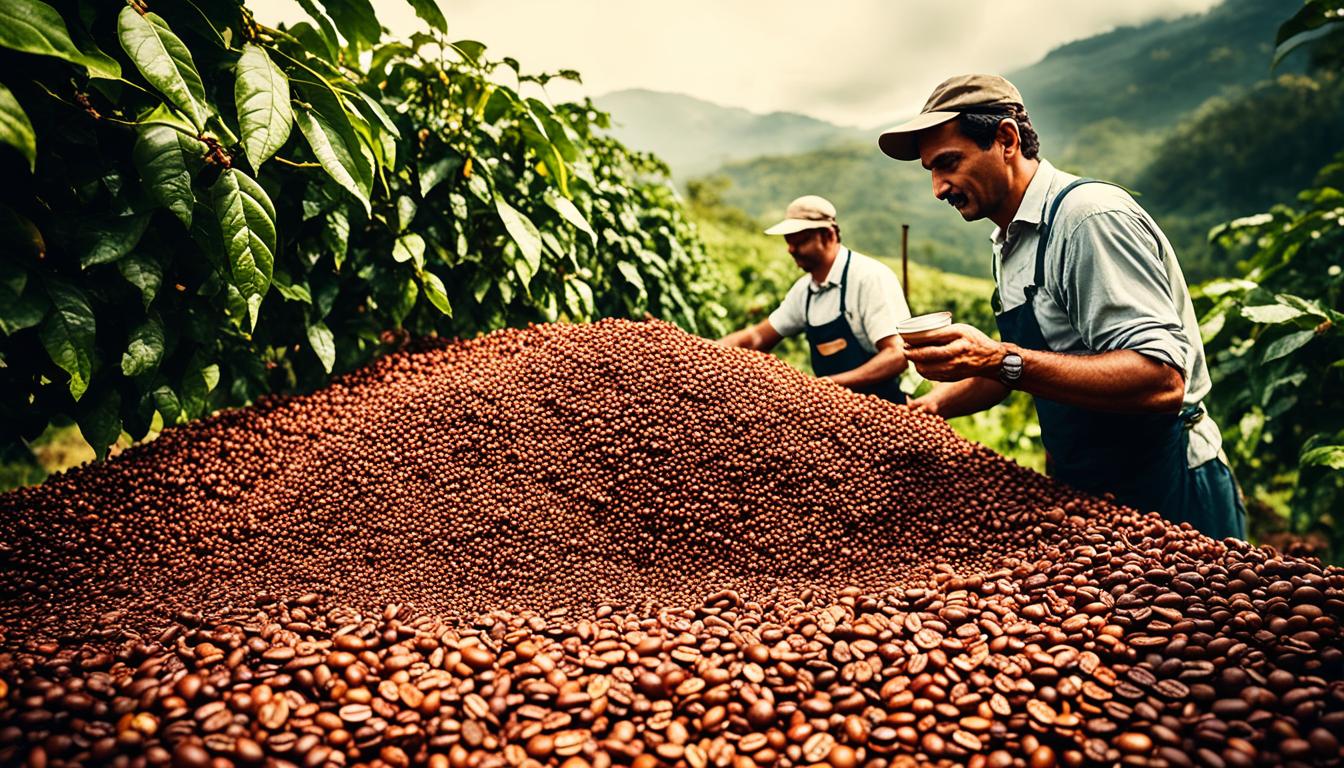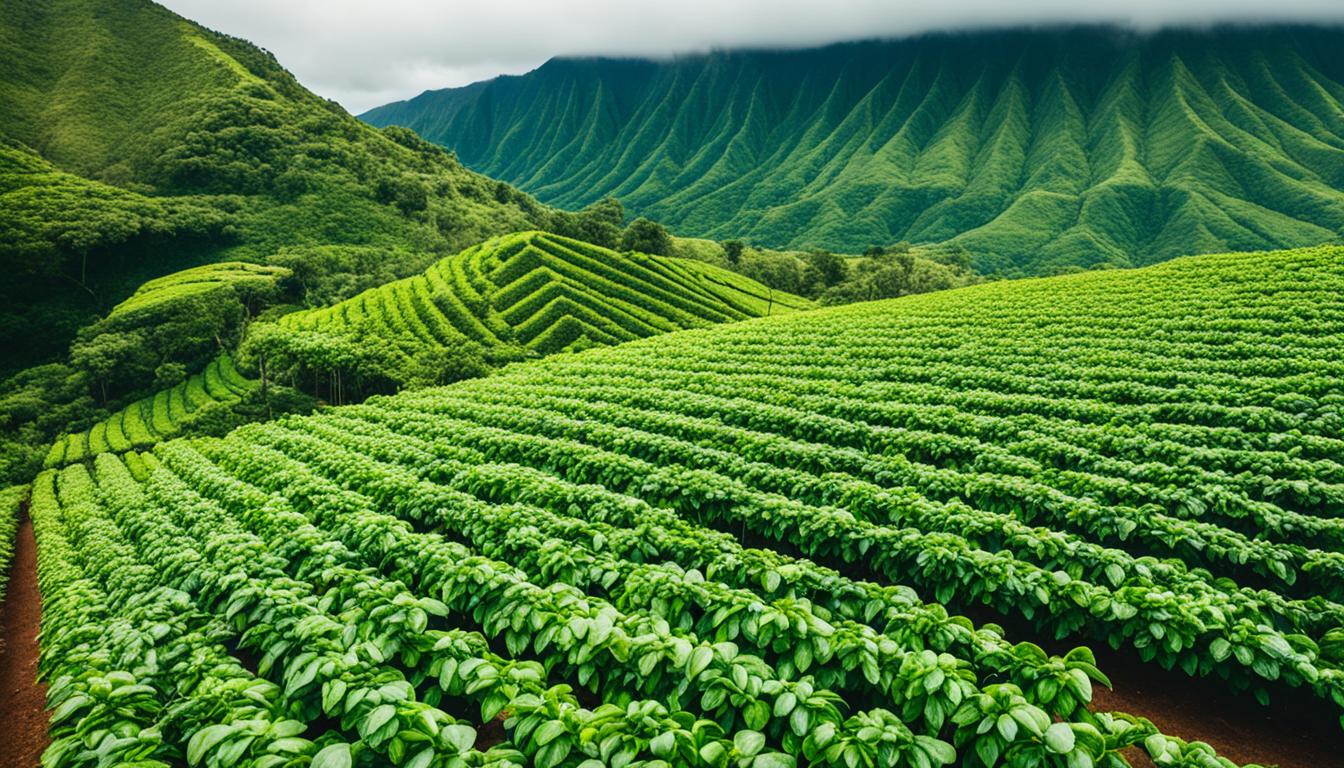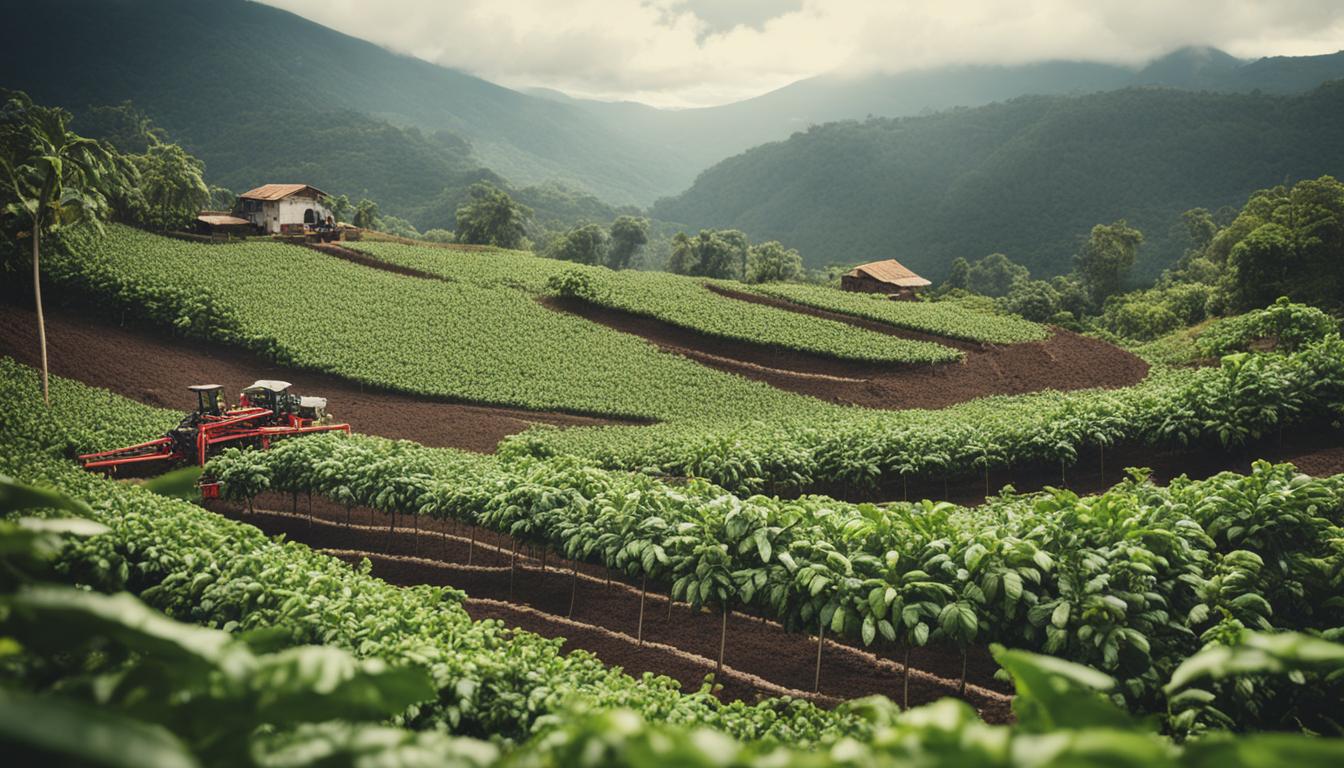Welcome to our blog post on preserving coffee heritage and biodiversity. As lovers of coffee, we know the importance of sustainable coffee farming and the preservation of coffee culture and history. The coffee industry has a significant impact on the environment and biodiversity, but there are ways we can ensure its long-term viability while minimizing the negative effects.
Preserving coffee heritage involves not only protecting heritage coffee varieties but also implementing sustainable agriculture practices that prioritize biodiversity conservation and environmental sustainability. By adopting these practices, we can safeguard the unique flavors, traditions, and natural ecosystems that make coffee production so special.
Key Takeaways:
- Preserving coffee heritage and biodiversity is crucial for the long-term sustainability of the coffee industry.
- Sustainable coffee farming practices can help minimize the negative impacts of large-scale coffee production on the environment.
- Agroforestry practices, like shade-grown coffee, promote habitat conservation and biodiversity preservation.
- Integrated Pest Management (IPM) techniques reduce reliance on synthetic pesticides and protect ecosystem health.
- Water conservation measures, such as drip irrigation and wastewater recycling, can help reduce the water footprint of coffee production.
Incorporating Agroforestry Practices
Agroforestry practices play a vital role in promoting sustainable coffee production. By combining the cultivation of trees and crops, large-scale coffee producers can reap numerous benefits for both their farms and the environment.
One of the key advantages of agroforestry is the provision of shade for coffee plants. By growing trees alongside coffee crops, we create a natural canopy that shields the coffee plants from excessive sunlight. This shade-grown coffee not only enhances the flavor profile of the beans but also reduces the need for synthetic fertilizers and pesticides, making it a more eco-friendly option.
In addition to shade, trees in agroforestry systems serve as crucial habitat for various wildlife species. They attract birds and insects that act as natural pest controllers, keeping populations of detrimental pests and diseases in check. This natural pest management decreases reliance on chemical interventions, further minimizing environmental impact.
Moreover, agroforestry practices contribute to water conservation efforts. Trees aid in retaining moisture in the soil, reducing the risk of erosion and promoting healthy water tables. This approach helps maintain adequate water resources and safeguards against the detrimental effects of drought and water scarcity.
By adopting agroforestry practices, large-scale coffee producers actively contribute to biodiversity conservation and habitat preservation. These integrated systems create a harmonious environment where coffee production coexists with diverse flora and fauna. The result is a thriving ecosystem that supports the well-being of both the coffee crops and the surrounding wildlife.
Image: Shade-grown coffee
Incorporating agroforestry practices into coffee production is a win-win solution. It benefits the environment by promoting habitat conservation and biodiversity, while also enhancing the quality and sustainability of coffee farming. By prioritizing agroforestry, we can create a future where coffee production thrives alongside nature, ensuring a cup of coffee that is not only delicious but also respectful of the planet we call home.
Implementing Integrated Pest Management Techniques
Integrated pest management (IPM) techniques play a pivotal role in managing pests and diseases during coffee production. By adopting a comprehensive approach that combines cultural, biological, and chemical control methods, we can effectively control pests while minimizing the environmental impact.
The use of synthetic pesticides in agriculture can have detrimental effects on ecosystems and human health. By reducing our reliance on these chemicals, we can promote the health of our natural environment. IPM encourages the use of alternative methods, such as cultural practices and biological control agents, to minimize the need for chemical interventions.
Through IPM, we prioritize the use of natural predators and beneficial insects to control pests. By harnessing the power of these natural pest control agents, we can maintain a balanced ecosystem within our coffee farms. This not only protects the health of our crops but also safeguards the wider biodiversity of the surrounding environment.
Implementing IPM techniques also helps prevent the buildup of pesticide residues in the environment. By using targeted and strategic approaches to pest control, we minimize the potential impact of synthetic pesticides on soil, water, and non-target organisms.
We recognize that a healthy and sustainable coffee industry is not only contingent on high-quality yields but also environmental stewardship. By integrating IPM practices into our production systems, we can achieve long-term sustainability while safeguarding the health of our ecosystems.
“Integrated pest management is a win-win approach that benefits both farmers and the environment. By employing sustainable pest control methods, we can protect the longevity of our coffee production while minimizing the ecological impact.”
The Benefits of Integrated Pest Management
| Benefits | Description |
|---|---|
| Reduced environmental impact | Minimizes the use of synthetic pesticides, reducing harm to ecosystems and non-target organisms. |
| Promotes biodiversity | Encourages natural pest control agents, such as beneficial insects, and maintains a balanced ecosystem within coffee farms. |
| Prevents pesticide residue accumulation | By using targeted pest control methods, we minimize the buildup of pesticide residues in the environment. |
By implementing integrated pest management techniques, we prioritize the health of our coffee crops, the biodiversity of our farms, and the overall sustainability of our industry.
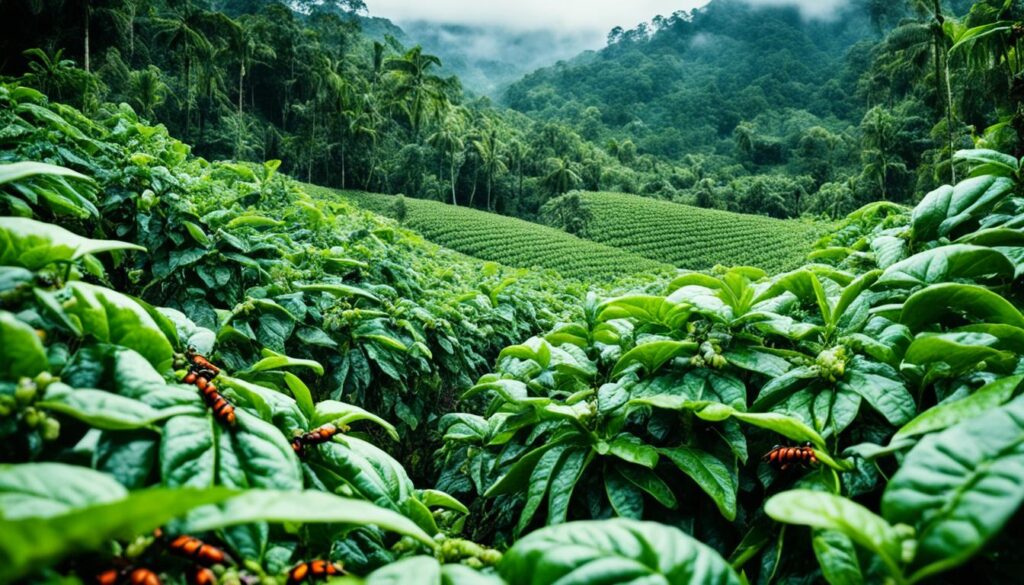
Implementing Water Conservation Measures
Coffee production is known for its high water consumption, and the increasing water scarcity poses a significant challenge for coffee growers. To address this issue, large-scale coffee producers can implement various water conservation measures to reduce their water footprint and contribute to sustainable water management.
Drip Irrigation: Efficient Water Delivery
One effective water conservation technique is the implementation of drip irrigation systems. Drip irrigation delivers water directly to the plant’s root zone, minimizing wastage from evaporation and runoff. This targeted approach ensures that water is efficiently utilized, reducing overall water consumption in coffee production.
Wastewater Recycling: Resource Optimization
Another innovative approach to water conservation in coffee production is wastewater recycling. By treating and recycling wastewater, coffee producers can optimize water resources and decrease reliance on freshwater sources. This sustainable practice not only conserves water but also reduces the environmental impact associated with wastewater disposal.
Cover Crops: Preventing Water Loss
Cover crops play a vital role in water conservation by preventing soil erosion, suppressing weed growth, and reducing water loss through evaporation. By planting cover crops in between coffee rows, large-scale coffee producers can enhance water retention in the soil and minimize water loss, thereby optimizing the use of water resources.
“Water conservation measures in coffee production help mitigate the effects of water scarcity and promote sustainable water management.”
Water Footprint: Reducing Impact
Implementing water conservation measures in coffee production leads to a reduced water footprint. By optimizing water usage, coffee growers can minimize their impact on water resources and contribute to a more sustainable coffee industry. For consumers and coffee enthusiasts, this means enjoying their favorite brew with a reduced environmental impact.
| Water Conservation Measures | Benefits |
|---|---|
| Drip Irrigation | – Efficient water delivery – Minimizes water wastage |
| Wastewater Recycling | – Optimizes water resources – Reduces reliance on freshwater sources |
| Cover Crops | – Prevents soil erosion – Minimizes water loss through evaporation |
By implementing these water conservation measures, large-scale coffee producers contribute to the preservation of water resources, reduce their ecological impact, and promote a more sustainable coffee industry for future generations.
Protecting and Restoring Natural Habitats
Coffee production can have detrimental effects on natural habitats, leading to deforestation, soil erosion, and biodiversity loss. At our large-scale coffee operations, we understand the importance of mitigating these impacts and actively working towards conserving and restoring natural habitats such as forests and wetlands. By implementing initiatives like reforestation, land conservation, and sustainable land use practices, we can make a positive difference in the environment.
Deforestation is a significant concern in coffee production, as it not only destroys precious natural habitats but also contributes to climate change. Our commitment to natural habitat conservation drives us to protect existing forests from further encroachment and actively restore degraded areas.
“Protecting and restoring natural habitats is crucial for conserving biodiversity and promoting ecosystem health.”
Restoring natural habitats, such as forests, can help replenish the soil, reduce erosion, and provide a home for diverse plant and animal species. Through reforestation efforts, we aim to create sustainable ecosystems that support coffee production while conserving biodiversity.
“Conserving natural habitats ensures a healthy environment for future generations.”
Land conservation is another essential aspect of our natural habitat conservation efforts. By designating protected areas, we aim to preserve critical ecosystems and prevent further degradation of natural habitats. These protected areas serve as sanctuaries for wildlife, enabling species to thrive and contribute to the overall biodiversity in coffee-growing regions.
“Sustainable land use practices are fundamental to safeguarding the environment for present and future generations.”
Implementing sustainable land use practices is crucial for minimizing the environmental impacts of coffee production. By adopting practices that focus on soil conservation, such as terracing and contour farming, we can reduce erosion and soil degradation. These practices also contribute to the overall health and resilience of the land, ensuring its long-term viability for future generations.
Benefits of Protecting and Restoring Natural Habitats
Our efforts to protect and restore natural habitats bring numerous benefits to the environment, biodiversity, and coffee production itself:
- Promotes biodiversity conservation and the preservation of unique plant and animal species
- Enhances ecosystem health and resilience
- Prevents soil erosion and degradation
- Improves water quality and protects watersheds
- Supports climate change mitigation through carbon sequestration
- Creates habitats for pollinators, benefiting coffee crops
“Our commitment to natural habitat conservation contributes to a sustainable future for coffee production and the planet.”
| Environmental Benefits | Coffee Production Benefits |
|---|---|
| Promotes biodiversity conservation | Preserves the unique flavors and qualities of coffee |
| Enhances ecosystem health and resilience | Provides a more stable and reliable coffee-growing environment |
| Prevents soil erosion and degradation | Ensures the long-term productivity of coffee farms |
| Improves water quality and protects watersheds | Contributes to the purity and taste of coffee |
| Supports climate change mitigation through carbon sequestration | Reduces the carbon footprint of coffee production |
| Creates habitats for pollinators | Ensures successful pollination and coffee bean formation |
We believe that by protecting and restoring natural habitats, we can contribute to the preservation of biodiversity, mitigate the environmental impacts of coffee production, and ensure a sustainable future for the coffee industry.
Supporting Social Sustainability
Large-scale coffee production can have significant social impacts on local communities, including displacement, exploitation, and loss of cultural heritage. At our company, we are committed to promoting social sustainability through various initiatives.
1. Fair Labor Practices
We ensure that our coffee workers receive fair wages and have safe and healthy working conditions. By enforcing fair labor practices, we prioritize the well-being and dignity of our workforce, fostering a positive working environment that values their contributions.
2. Community Development
We believe in investing in the communities where we operate. Through community development initiatives, we help improve infrastructure, education, and access to essential services. By empowering local communities, we strive to create long-term positive change and sustainable growth.
3. Cultural Preservation
We recognize the importance of preserving and celebrating the cultural heritage of coffee-growing regions. We actively support local cultural practices and traditions, working with communities to safeguard their unique identities. By promoting cultural preservation, we contribute to the richness and diversity of coffee cultures around the world.
“By prioritizing social sustainability, we believe that we can create a coffee industry that not only produces great coffee but also positively impacts the livelihoods and well-being of local communities.”
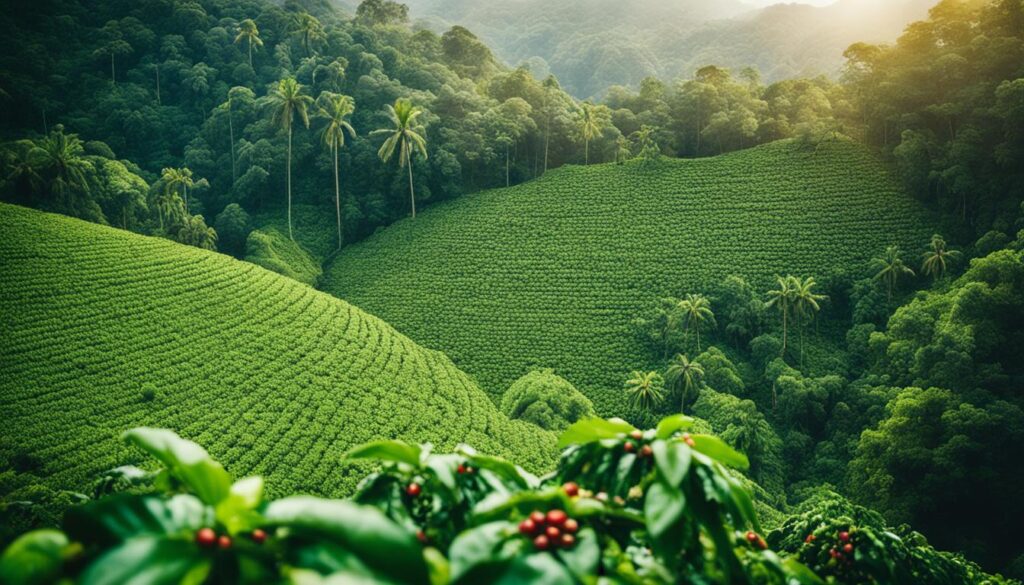
| Benefit | Description |
|---|---|
| Improved livelihoods | By providing fair wages and working conditions, we enhance the economic well-being of coffee workers and their families. |
| Community empowerment | Through community development initiatives, we empower local communities, enabling them to drive their own sustainable growth. |
| Cultural heritage preservation | Supporting cultural preservation efforts ensures that the unique traditions and practices of coffee-growing regions are celebrated and preserved for future generations. |
| Social cohesion | By fostering a sense of community and social cohesion, we create a supportive environment that promotes inclusivity and collaboration. |
Reducing Greenhouse Gas Emissions
Coffee production is a significant contributor to greenhouse gas emissions, which have detrimental effects on climate change and the environment. To mitigate these impacts, large-scale coffee producers can implement key strategies to reduce their greenhouse gas emissions and promote sustainable practices.
- Utilizing Renewable Energy Sources: By transitioning to renewable energy sources such as solar or wind power, coffee producers can minimize their reliance on fossil fuels and reduce their carbon footprint. Implementing renewable energy systems in coffee processing facilities and farms can significantly decrease greenhouse gas emissions.
- Optimizing Waste Management: Proper waste management practices, including composting coffee pulp and utilizing anaerobic digesters, can help reduce greenhouse gas emissions. By converting organic waste into valuable resources, coffee producers can minimize the release of methane, a potent greenhouse gas.
- Promoting Sustainable Land Use: Adopting sustainable land use practices, such as agroforestry and reforestation, can contribute to carbon sequestration and offset greenhouse gas emissions. Trees and vegetation play a crucial role in absorbing carbon dioxide, making sustainable land use an effective strategy in mitigating climate change.
“By implementing these strategies, coffee producers can contribute to the global effort in combating climate change and building a more sustainable future for the coffee industry.”
Reducing greenhouse gas emissions is not only beneficial for the environment but also for the long-term viability of the coffee industry. By implementing sustainable practices, coffee producers can showcase their commitment to environmental stewardship and inspire others to follow suit.
The Impact of Greenhouse Gas Emissions
Greenhouse gas emissions from coffee production contribute to the overall increase in global greenhouse gas concentrations. The main sources of emissions in the coffee industry are deforestation, primarily associated with land clearing, and the use of synthetic fertilizers.
| Emission Source | Percentage Contribution |
|---|---|
| Deforestation | 65% |
| Synthetic Fertilizer Use | 35% |
The table above highlights the significant role of deforestation in coffee production’s greenhouse gas emissions. It shows that addressing deforestation is crucial for reducing the industry’s overall environmental impact.
Conclusion
Preserving coffee heritage and biodiversity is essential for the long-term sustainability of the coffee industry. At [Brand], we are committed to incorporating sustainable practices to ensure the preservation of coffee culture, heritage varieties, and the natural ecosystems that support coffee production.
By implementing strategies such as agroforestry practices, integrated pest management, water conservation, habitat protection, social sustainability, and greenhouse gas reduction, we can minimize the negative impact on the environment and contribute to biodiversity conservation.
It is crucial for us to adopt a comprehensive and integrated approach that considers the ecological, social, and economic dimensions of coffee production. This approach will safeguard the future of unique coffee cultures and ecosystems, while also promoting the long-term viability of the coffee industry.
At [Brand], we believe that sustainable coffee production is not just about environmental sustainability but also about preserving the rich history and diversity of coffee. By working together, we can ensure that future generations will continue to enjoy the exceptional flavors and cultural significance of coffee while protecting the natural resources that make it possible.
FAQ
What are some strategies for preserving coffee heritage and biodiversity?
Some strategies include incorporating agroforestry practices, implementing integrated pest management techniques, implementing water conservation measures, protecting and restoring natural habitats, supporting social sustainability, and reducing greenhouse gas emissions.
How can agroforestry practices benefit coffee production?
Agroforestry practices such as growing trees alongside crops can provide shade for coffee plants, reduce the need for synthetic fertilizers and pesticides, provide habitat for wildlife, conserve water, and prevent soil erosion.
What is integrated pest management (IPM) and how does it relate to coffee production?
Integrated pest management involves using a combination of cultural, biological, and chemical control methods to manage pests and diseases. By reducing reliance on synthetic pesticides and promoting the use of natural predators, IPM techniques can minimize the negative environmental impacts of coffee production.
How can water conservation measures be implemented in coffee production?
Water conservation measures in coffee production can include using drip irrigation, recycling wastewater for irrigation, and planting cover crops. These practices help reduce water usage and prevent water loss through evaporation.
How can coffee producers protect and restore natural habitats?
Coffee producers can protect and restore natural habitats through initiatives like reforestation, land conservation, and sustainable land use practices. These efforts help mitigate deforestation, soil erosion, and loss of biodiversity associated with coffee production.
What can be done to support social sustainability in the coffee industry?
Supporting social sustainability in the coffee industry involves fair labor practices, community development initiatives, and cultural preservation efforts. This includes providing fair wages and working conditions, investing in community infrastructure and education, and supporting local cultural practices and traditions.
How can coffee producers reduce greenhouse gas emissions?
Coffee producers can reduce greenhouse gas emissions by utilizing renewable energy sources, reducing waste in the production process, and promoting sustainable land use practices. These measures help mitigate the impacts of climate change and contribute to the overall sustainability of the coffee industry.
Why is preserving coffee heritage and biodiversity important?
Preserving coffee heritage and biodiversity is crucial for the long-term sustainability of the coffee industry. It ensures the preservation of unique coffee cultures, heritage varieties, and the natural ecosystems that support coffee production. It also helps maintain the history and traditions associated with coffee, while promoting environmental and social sustainability.

